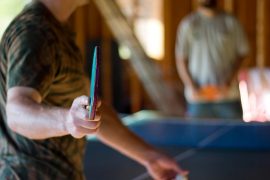Today’s guest post is from Laura Overdeck, the ingenious creator of Bedtime Math. Don’t know what that is? Keep reading. And then go sign up for their daily email. You won’t regret it!
As kids go back to school, it’s natural for parents to look at their bright-eyed offspring and wonder what they’ll go on to do in life. Chances are they’re hoping their kids will major in something substantial in college to lay the foundation for a great career. Unfortunately, that isn’t what we see happening: According to the National Center for Education Statistics, today more U.S. undergraduates are majoring in “leisure and recreation studies” than in all physical sciences combined (chemistry, physics, astronomy…you get the idea). And there are more than twice as many majoring in leisure studies as in math.
Why does this happen? Why is our next generation running scared from the subjects that involve math? Can we make math the fun leisure activity that kids flock to do?
The problem is that our culture doesn’t view math the way we view reading. Everyone knows to read to children from a young age, and most educated parents do. By the time kids get to kindergarten, even if they can’t read yet, they probably have a warm, cozy feeling about books. To them, reading is a leisure activity, an activity you do for fun when you have free time. Math, by contrast, doesn’t get the same warm, fuzzy introduction as the bedtime story. While there are plenty of magnetic number sets and 1-10 counting puzzles, for most families math at home stops as soon as the children reach toddlerdom. As a result, for a lot of kids their first real experience with math happens in school, with all the associations of homework, drilling and tests. That’s not going to make it feel like leisure. It feels like a chore.
It’s no wonder, then, that kids start off on the wrong foot with their relationship with math.
Kids should view math as fondly as they think about storybooks. While your child plugs away at the usually dry math material from school, it’s good to counter that with fun math at home as an antidote. By the way, that doesn’t mean forced, contrived set-ups where your child can see right through to your intentions. Luckily, there are plenty of fun activities ripe with “stealth” math that may be part of your day already:
- Baking: Doubling recipes requires multiplying; cutting in half requires dividing; measuring 1/4-cups or 1/4-tsps uses fractions. Any time you bake, you’re quantifying ratios to make magic in the oven. Toddlers can participate by counting out chocolate chips, and of course eating them as a bonus.
- Building: Anything that involves measuring gets kids counting, adding, and multiplying. Lego and other building toys revolve around numbers, too. And we all see how kids can entertain themselves with a bunch of cardboard boxes, especially if told they’re off limits. Cutting up pieces to assemble a fort all revolves around measurement.
- Planning: For example, setting up party favors. They’re all sold in different quantities: 10 in one pack, 24 in another, 18 in a third. If there are 16 kids coming over, how many packs of each do you need, and what’s left over? Even putting out breakfast or dinner takes some planning and counting.
- Sports and exercise: Kids love stopwatches, and watching the seconds tick off gives kids great exposure to counting. Distances and heights require measurement, and even counting jumping jacks, baseball swings, or the kicks to get a soccer ball to the end of a field, can involve numbers.
All of these activities contain a ton of math as a natural part of the process, and this list is just a start. When kids get absorbed in a favorite activity, they don’t even notice they’re learning, just like when they read a bedtime story.
To that point, math can become a part of bedtime as well. Six months ago I founded Bedtime Math, a free website that offers a fun nightly math problem every night – about electric eels, chocolate chips, zip lines into the neighbor’s pool. Again, the idea is to take kids’ absolute favorite topics and sneak some math in there. After just six months we have over 20,000 people following us through the daily email, the website or Facebook, and parents have written that their previously math-resistant children now ask for Bedtime Math at night, thanks to this new spin on numbers.
Again, it’s all about catching kids while they still think numbers are fun, and building on that mindset. By making math a fun part of favorite natural routines, kids will think of numbers as recreation instead of compulsory drudgery. When they enter school with that new world view, they will have an entirely different, incredibly positive experience with math at school. And with that foundation, maybe they won’t have to sink to majoring in leisure studies when they grow up. They’ll major in math instead – for fun.
Laura, you’re singing my song! The beauty of Bedtime Math is that it offers three levels of difficulty. Parents don’t have to try to figure out what they should expect their toddler to do or how difficult the math should be for their 2nd grader. And I guarantee — GUARANTEE! — that if you give this a try, you’ll find yourself injecting math all over the darned place.
So what do you think about these sneaky math ideas? Are you ready to throw away the worksheets and flash cards? Have you figured out some easy ways to encourage your kids to do math — without their even knowing it? Share your ideas in the comments section.
